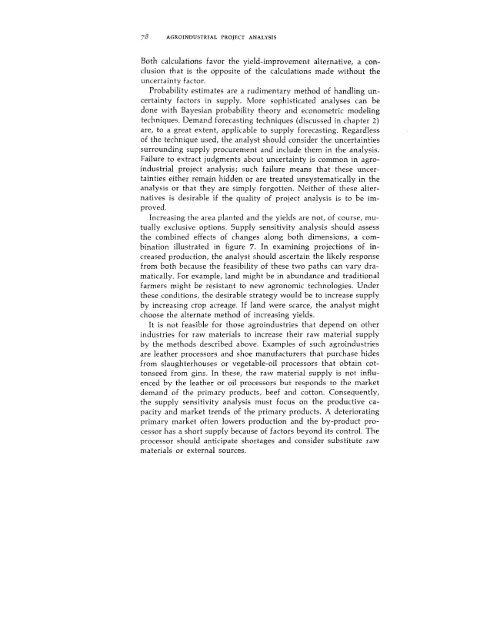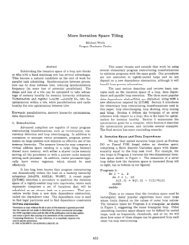Agroindustrial project analysi
Agroindustrial project analysi
Agroindustrial project analysi
- No tags were found...
Create successful ePaper yourself
Turn your PDF publications into a flip-book with our unique Google optimized e-Paper software.
78 AGROINDUSTRIAL PROJECT ANALYSISBoth calculations favor the yield-improvement alternative, a conclusionthat is the opposite of the calculations made without theuncertainty factor.Probability estimates are a rudimentary method of handling uncertaintyfactors in supply. More sophisticated analyses can bedone with Bayesian probability theory and econometric modelingtechniques. Demand forecasting techniques (discussed in chapter 2)are, to a great extent, applicable to supply forecasting. Regardlessof the technique used, the analyst should consider the uncertaintiessurrounding supply procurement and include them in the <strong>analysi</strong>s.Failure to extract judgments about uncertainty is common in agroindustrial<strong>project</strong> <strong>analysi</strong>s; such failure means that these uncertaintieseither remain hidden or are treated unsystematically in the<strong>analysi</strong>s or that they are simply forgotten. Neither of these alternativesis desirable if the quality of <strong>project</strong> <strong>analysi</strong>s is to be improved.Increasing the area planted and the yields are not, of course, mutuallyexclusive options. Supply sensitivity <strong>analysi</strong>s should assessthe combined effects of changes along both dimensions, a combinationillustrated in figure 7. In examining <strong>project</strong>ions of increasedproduction, the analyst should ascertain the likely responsefrom both because the feasibility of these two paths can vary dramatically.For example, land might be in abundance and traditionalfarmers might be resistant to new agronomic technologies. Underthese conditions, the desirable strategy would be to increase supplyby increasing crop acreage. If land were scarce, the analyst mightchoose the alternate method of increasing yields.It is not feasible for those agroindustries that depend on otherindustries for raw materials to increase their raw material supplyby the methods described above. Examples of such agroindustriesare leather processors and shoe manufacturers that purchase hidesfrom slaughterhouses or vegetable-oil processors that obtain cottonseedfrom gins. In these, the raw material supply is not influencedby the leather or oil processors but responds to the marketdemand of the primary products, beef and cotton. Consequently,the supply sensitivity <strong>analysi</strong>s must focus on the productive capacityand market trends of the primary products. A deterioratingprimary market often lowers production and the by-product processorhas a short supply because of factors beyond its control. Theprocessor should anticipate shortages and consider substitute rawmaterials or external sources.













![Problem 1: Loop Unrolling [18 points] In this problem, we will use the ...](https://img.yumpu.com/36629594/1/184x260/problem-1-loop-unrolling-18-points-in-this-problem-we-will-use-the-.jpg?quality=85)


